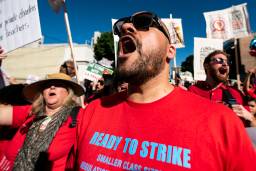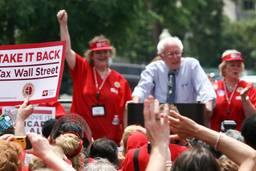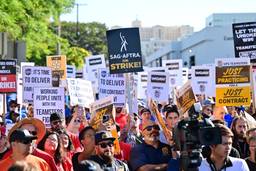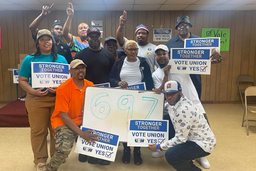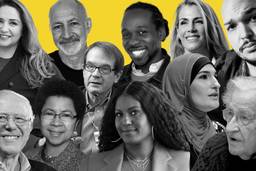On Friday October 22, workers at 10 Jimmy John’s franchises in the Twin Cities rejected formal recognition of the Jimmy John’s Workers Union in a heartbreakingly close (87−85) National Labor Relations Board (NLRB) vote.
To some labor analysts, Jimmy John’s defeat demonstrates Congress needs to pass the Employee Free Choice Act. True enough: the Jimmy John’s election is a testament to why we desperately need to change the rules on union organizing. Yet the Jimmy John’s struggle reveals much more about the problems inherent in the NLRB election process, namely:
- Unionism is about collectivity, but the NLRB election process is about individualism.
- NLRB elections shift the terms of the debate, making the election more about the union as an entity than employer practices.
- NLRB elections suck solidarity, the heart and soul of unionism, out of organizing.
To reverse labor’s continuing decline, trade unionists must confront these issues. Unionism, by definition, is a collective pursuit. It is about solidarity, struggle, and sacrifice — about workers joining to fight for common concerns. It is about collective decision-making — about workers acting and, truth be told, often thinking as a group. In contrast, NLRB elections are about individualism — pure and simple. By definition, an NLRB election is, as put in recent union-sponsored legislation, about individual “free choice.”
Anti-labor conservatives realize that it benefits the employers’ cause to frame the discussion in terms of individual rights: the “right” of a scab to cross a picket line, the “right” of a worker not to join the union, the “right” of an employer to denigrate unions to a captive audience of workers. For this very reason, employer-funded anti-union organizations adopt such names as the National Right to Work Foundation, posing themselves as the guardians of individual worker rights.
At Jimmy John’s, according to union organizers, the appeal to individualism was a key part of the management anti-union campaign. Prior to filing for the NLRB election, workers organized around issues of common concern and organized collective actions. Once the election process started, however, the terrain shifted from collective action to individualism.
As Jimmy John’s worker and IWW activist Erik Forman explains,
the fast food industry is built on favoritism. Bosses get workers to think that they are their friends by allowing their favorites to punch in late, giving us a free meal here and there, not enforcing the dress code as strictly, or even just being friendly instead of abusive. If you rock the boat, all of these little benefits go away. The boss will tighten up the rules and target you.
Branch supervisors implied these special deals would go away and played up their individual relationships with workers. All typical union-busting tactics.
This individualistic framework fostered by NLRB elections raises several problems:
- First, people don’t necessarily make the same decisions as individuals as they would make as part of a group. Ask any organizer: the best decisions are made collectively.
- Second, approaching unionization as an individual decision requires workers to approach employers from a position of weakness. Yet labor’s greatest strength comes in numbers — in the solidarity of workers acting together.
- Finally, as a variety of legal historians have pointed out, the labor movement approached the question of unionization as an industry or class question. The labor movement did not consider it the choice of any individual worker to undercut union standards in an industry.
The Jimmy John’s union faced another problem. According to IWW organizer David Boenke, once the Jimmy John’s workers filed for an election, the terms of debate shifted. Prior to the filing, the focus centered on the workers’ common grievances against the employer. The union organized around issues such as sexual harassment, getting fixed work schedules or increasing the number of drivers on a shift. In other words, the focus was squarely on employer practices.
Once the union filed for an election, however, the employer made the IWW the issue. Anti-union consultants argued workers would be forced to pay dues, even though the IWW was not seeking mandatory dues, and given its grassroots structure, any voluntary dues are minimal. The employer also red-baited the IWW, noting its radical origins. While any individual argument may not have swayed workers, together they shifted the focus from employer practices to the union as an entity.
According to some organizers, this was one of the most effective parts of the employer’s campaign. As Boenke notes, “We tried to avoid this question and keep the focus on management. But since the vote is yes or no to union representation, the question is hard to avoid.”
Another problem confronting organizers is that the NLRB election process does not how organizing typically works. Solidarity typically develops as a process. This concept should be familiar to any competent workplace organizer — you build strength one small action at a time. To anyone who has participated in a strike, this process should be clear. Battle lines are drawn between labor and management. The group begins developing a common identity. More militant workers bring along their more hesitant co-workers. As any student of labor history knows, the dramatic actions in the 1930s which built the modern labor movement were spurred by a militant minority.
An NLRB election is about something quite different. Rather than how a courageous minority can inspire co-workers, it is about where the vast middle stands after weeks of barrage by anti-union consultants. An election is not about building of steam; it is about delay and stagnation. Rather than a process of growth, an election is about a snapshot in time. That is why NLRB elections will never provide the upsurge necessary to revive the labor movement.
Difficult questions, and the need for new ideas
Leading up to the decision to conduct an NLRB vote, Jimmy John’s workers faced some difficult decisions. One path was to hold an NLRB election to become certified as the bargaining representative for Jimmy John’s workers and negotiate a contract. Advocates of this approach correctly noted that without an election, the employer would never negotiate a contract. Jimmy John’s owner claimed that the Jimmy John’s union was “not a real union.” Winning the election would bestow the government’s stamp of legitimacy and legally obligate the company to negotiate. Thus, the election route provided a clear path forward.
An alternative viewpoint advocated skipping the election and instead relying on the grassroots tactics that had, thus far, characterized the Jimmy John’s struggle. The shop floor power, the direct actions in the workplace, and the mass picketing did not depend on government sanction. While winning the election would force the employer to the bargaining table, only grassroots militancy could win them improvements.
According the Cornell University researcher Kate Bronfenbrenner, less than half of NLRB elections resulted in a contract after one year. For low wage workers, this problem is particularly acute.
The Jimmy John’s union has bravely taken on an extremely difficult task— organizing a low-wage, high turnover workforce in an industry with among the lowest union densities in the United States. So it is not surprising that they have confronted difficult questions. Indeed, the issues these young Jimmy John’s activists are grappling with are as old as the trade union movement itself.
Should workers rely on government support for their efforts? What makes a union? What is the true source of worker’s power? It is the answer to these questions which will determine labor’s future, not what is the best method of making house calls or which candidates to elect.
The activists ultimately chose the NLRB election route, in part because the alternative — winning improvements outside of a contractual framework — represents uncharted territory in modern times. However, even though they lost the election, the union vows to continue their struggle.
As Ayo Collins, a Jimmy John’s delivery driver, noted, “we have a mandate— more than 85 of us are committed to continuing the fight for decent wages, consistent scheduling, sick days, and the basic respect and dignity that all workers deserve. This is just the beginning of the fight.”
The labor movement desperately needs new ideas. Its future lies in unconventional unionism: in the willingness to break with the conservatism of labor in recent decades to develop new forms of organization and struggle. Undoubtedly, Jimmy John’s activists will continue to face tough issues in their drive to organize the fast food industry. Whatever direction they choose, it is their openness to consider new ways of doing things which represents the best hope for labor’s future.
Joe Burns, a former local union president active in strike solidarity, is a labor negotiator and attorney. He is the author of the book Reviving the Strike: How Working People Can Regain Power and Transform America (IG Publishing, 2011).
